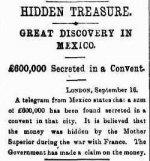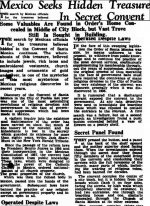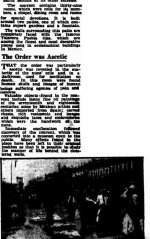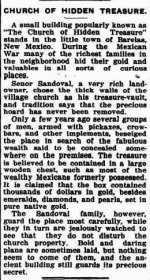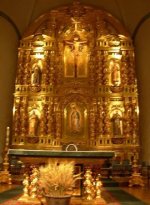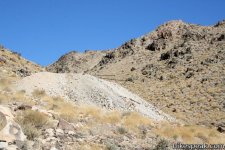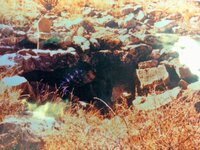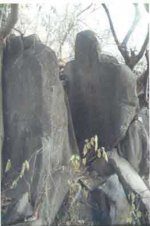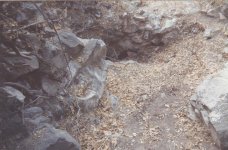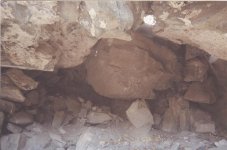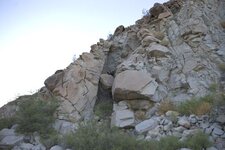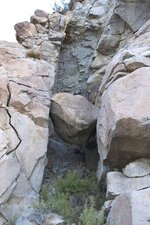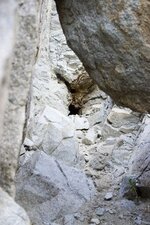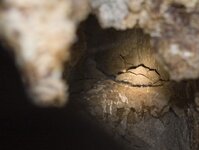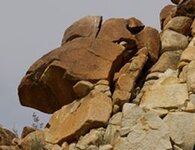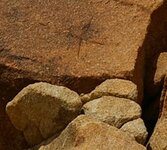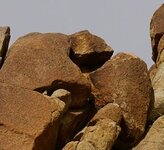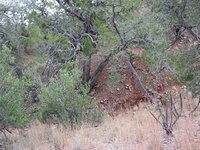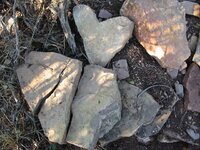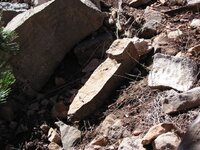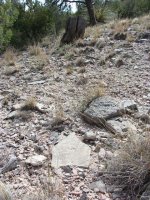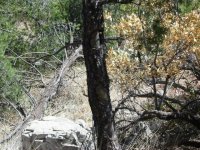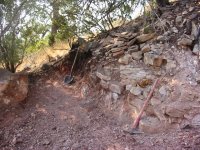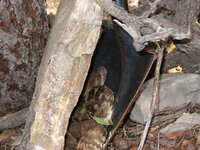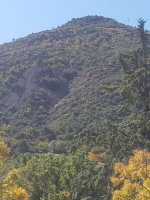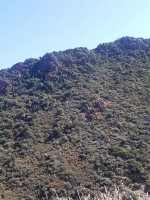Oroblanco
Gold Member
- Jan 21, 2005
- 7,841
- 9,854
- Detector(s) used
- Tesoro Lobo Supertraq, (95%) Garrett Scorpion (5%)
Not to try to pick a fight with anyone here over this aspect of the Jesuit treasure legends, but IMHO we as treasure hunters are selling ourselves short when we just ignore the Franciscan padres who replaced the Jesuits in Pimeria.
For starters, consider that smelting slag is found built right into the very walls of the Franciscan missions at both Tumacacori and San Xavier del Bac. Now it is entirely possible that they (the Franciscan padres) had simply picked up the slag left behind by earlier Jesuit or Spanish or Mexican miners and used it to decorate the walls as a nice dark contrast. However it is circumstantial evidence that the Franciscans themselves could have been involved in at least smelting silver ores at their missions. And yes before someone corrects me, I am fully aware that the Franciscan missions at these two locations were supposedly just rebuilding the crumbling Jesuit missions which had been there first.
Next, consider that the impressive solid silver altar service witnessed by several of the earliest American visitors to San Xavier del Bac, was during the Franciscan period not the Jesuits. This altar service was estimated to be worth at least $40,000 in 1850s dollars. This impressive silver treasure is lost today, according to the stories it was hidden during the Civil War and the location has been lost since.
It is true that the Franciscans arrived in 1768, and impressed on the Indians that they were not there merely to become their new "bosses" (I am using an Americanism not quoting) for endless forced labors, which greatly helped in their being accepted by the Indians as their spiritual 'fathers'. The various business enterprises that were formerly run by the Jesuits, had been "plundered" by 1768 and the Visitador General (Galvez) ordered the administration of all of these business enterprises (to include the farming, livestock ranching, mining etc) to be returned to the Padres, so the Franciscans assumed control over all these businesses just as had the Jesuits before.
Further, one of the little known lost mines, the Lost Mojave mine, which you can see from the road west of Quartzsite and visit in person if you wish (it is played out however) was a Franciscan mine. The Franciscans attempted to found two missions on the Colorado river near Yuma, (both on the CA side if memory serves - correction welcomed) and the Indians rebelled against their masters, killing the padres and driving the Spanish out. According to a Franciscan source, years later a party of Mexican treasure hunters dug in the old Franciscan mission ruins and recovered a treasure of gold, gold which had been the product of the Franciscan missionaries mining activities. Unlike the Jesuits, the Franciscans do not deny that their missionaries had been involved in mining, after all every one of the missions were expected to become self supporting, the padres having (in the legal sense) that of a legal guardian or parent for the poor innocent Indians whom were viewed as "children" in the eyes of the padres and the Spanish authorities, unable to administer their own business enterprises without someone acting as a "parental control".
One of the sources is available online (free) at:
https://ia800503.us.archive.org/16/items/TheFranciscansInArizona/TheFranciscansInArizona.pdf
It was written by a Franciscan padre so do not expect to read a full description of all the silver mines and the gold mines, as Franciscan padres are bound to protect and defend their Order against any sort of imputation of wrongdoing. But it is enlightening to realize that these later padres were doing very much the exact same type of works in the American southwest, just arriving later and leaving later. Plus as to hidden treasures and mines, while the Jesuits were 'rounded up' and expelled, likewise the Franciscans were also ordered out of what was then Mexico, I believe the year was 1823, and they were given a full YEAR to get out. This allowed plenty of time to hide mines and bury treasures for the return of the padres at a later date. Also it is quite reasonable to understand why the padres would be hiding the wealth and mines from the greedy and grasping Mexican government, much as many folks today will take advantage of every possible exemption to pay the least possible income taxes.
Besides the Franciscans, we ought not ignore other possible candidates - remember that the first documented placer gold mining within Arizona is recognized as the work of an Augustinian padre at the mission near Baboquiviri, padre Manuel Lopez circa 1774. (Maurice Johnson, Placer Gold Deposits of Arizona, pp 1) Don't focus ONLY on the Jesuits!
Any thoughts or opinions? Thanks in advance,
Oroblanco





For starters, consider that smelting slag is found built right into the very walls of the Franciscan missions at both Tumacacori and San Xavier del Bac. Now it is entirely possible that they (the Franciscan padres) had simply picked up the slag left behind by earlier Jesuit or Spanish or Mexican miners and used it to decorate the walls as a nice dark contrast. However it is circumstantial evidence that the Franciscans themselves could have been involved in at least smelting silver ores at their missions. And yes before someone corrects me, I am fully aware that the Franciscan missions at these two locations were supposedly just rebuilding the crumbling Jesuit missions which had been there first.
Next, consider that the impressive solid silver altar service witnessed by several of the earliest American visitors to San Xavier del Bac, was during the Franciscan period not the Jesuits. This altar service was estimated to be worth at least $40,000 in 1850s dollars. This impressive silver treasure is lost today, according to the stories it was hidden during the Civil War and the location has been lost since.
It is true that the Franciscans arrived in 1768, and impressed on the Indians that they were not there merely to become their new "bosses" (I am using an Americanism not quoting) for endless forced labors, which greatly helped in their being accepted by the Indians as their spiritual 'fathers'. The various business enterprises that were formerly run by the Jesuits, had been "plundered" by 1768 and the Visitador General (Galvez) ordered the administration of all of these business enterprises (to include the farming, livestock ranching, mining etc) to be returned to the Padres, so the Franciscans assumed control over all these businesses just as had the Jesuits before.
Further, one of the little known lost mines, the Lost Mojave mine, which you can see from the road west of Quartzsite and visit in person if you wish (it is played out however) was a Franciscan mine. The Franciscans attempted to found two missions on the Colorado river near Yuma, (both on the CA side if memory serves - correction welcomed) and the Indians rebelled against their masters, killing the padres and driving the Spanish out. According to a Franciscan source, years later a party of Mexican treasure hunters dug in the old Franciscan mission ruins and recovered a treasure of gold, gold which had been the product of the Franciscan missionaries mining activities. Unlike the Jesuits, the Franciscans do not deny that their missionaries had been involved in mining, after all every one of the missions were expected to become self supporting, the padres having (in the legal sense) that of a legal guardian or parent for the poor innocent Indians whom were viewed as "children" in the eyes of the padres and the Spanish authorities, unable to administer their own business enterprises without someone acting as a "parental control".
One of the sources is available online (free) at:
https://ia800503.us.archive.org/16/items/TheFranciscansInArizona/TheFranciscansInArizona.pdf
It was written by a Franciscan padre so do not expect to read a full description of all the silver mines and the gold mines, as Franciscan padres are bound to protect and defend their Order against any sort of imputation of wrongdoing. But it is enlightening to realize that these later padres were doing very much the exact same type of works in the American southwest, just arriving later and leaving later. Plus as to hidden treasures and mines, while the Jesuits were 'rounded up' and expelled, likewise the Franciscans were also ordered out of what was then Mexico, I believe the year was 1823, and they were given a full YEAR to get out. This allowed plenty of time to hide mines and bury treasures for the return of the padres at a later date. Also it is quite reasonable to understand why the padres would be hiding the wealth and mines from the greedy and grasping Mexican government, much as many folks today will take advantage of every possible exemption to pay the least possible income taxes.
Besides the Franciscans, we ought not ignore other possible candidates - remember that the first documented placer gold mining within Arizona is recognized as the work of an Augustinian padre at the mission near Baboquiviri, padre Manuel Lopez circa 1774. (Maurice Johnson, Placer Gold Deposits of Arizona, pp 1) Don't focus ONLY on the Jesuits!
Any thoughts or opinions? Thanks in advance,
Oroblanco







